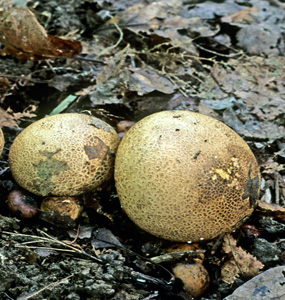Scleroderma citrinum

Image Courtesy of Emily Johnson
| Click to Enlarge |
| Click For Image Gallery |
|
Group of Fungi: Earthballs Family: Sclerodermataceae Latin Name: Scleroderma citrinum Pers. Common Name: Common Earthball Description: Globose to somewhat flattened structure, 1–3 in (2.5–7.5 cm) across; outer surface covered with large rough warts, yellow to orange-yellow to yellow-brown, developing a ragged opening at the top of the fruiting body; outer wall up to 1/4 in (0.5 cm) thick, tough, leathery; spore mass white in very young fruiting bodies but soon becoming purplish-brown to almost black; lowermost portion of the fruiting body sterile and thus without spores; spores blackish brown in mass. Biological Role: Forms mycorrhizal associations with forest trees. Habitat: On the ground or associated with wood debris in broadleaf forests; occurring as solitary fruiting bodies, in small groups or scattered. Geographical Distribution: Widely distributed throughout North America. Comments: The earthballs could be confused with puffballs but have a very different biological role. Morphologically, they also have a much thicker outer wall and the color of the spore mass of a mature specimen is unlike that of any puffball. It is not uncommon to find another fungus (Boletus parasiticus, commonly known as the Parasitic Bolete) apparently parasitizing the fruiting bodies of Scleroderma citrinum. Earthballs are not considered to be edible, and Scleroderma citrinum is poisonous. |
| Go Back |